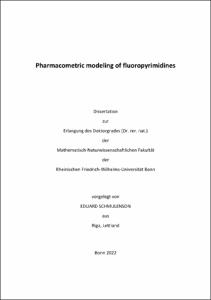Pharmacometric modeling of fluoropyrimidines

Pharmacometric modeling of fluoropyrimidines

| dc.contributor.advisor | Jaehde, Ulrich | |
| dc.contributor.author | Schmulenson, Eduard | |
| dc.date.accessioned | 2023-03-07T16:12:58Z | |
| dc.date.available | 2023-03-07T16:12:58Z | |
| dc.date.issued | 07.03.2023 | |
| dc.identifier.uri | https://hdl.handle.net/20.500.11811/10669 | |
| dc.description.abstract | The fluoropyrimidine drugs fluorouracil (5FU) and capecitabine are widely used for the treatment of various solid tumors. Despite the long-term clinical experience with these drugs a substantial proportion of patients is suboptimally dosed, leading to a highly variable treatment outcome and toxicity, respectively. Pharmacometric modeling is potentially useful to address these issues and to provide optimal dose regimens for individual patients. The aim of this work was to develop and apply pharmacometric models to gain a better understanding of the pharmacokinetics (PK) and pharmacodynamics of 5FU and capecitabine in order to improve anticancer therapy. These models were used for simulation of different dosing regimens investigating the influence of various sources of variability. A comprehensive literature review on the current status and future outlooks on therapeutic drug monitoring (TDM) of 5FU was performed. It revealed strong supporting evidence for conducting a 5FU-TDM to enable optimal therapy response and safety, particularly in combination with routine pharmacogenetic testing. Incorporating pharmacometric models into clinical routine can potentially assist clinicians in finding a proper 5FU dose even before starting therapy. Population PK models of capecitabine, the tyrosine kinase inhibitor regorafenib and their respective metabolites were developed to investigate potential drug-drug interactions between both drugs. The impact of the interaction was quantified via simulation analyses. Covariate analyses of the successfully developed models revealed that the cumulative area under the curve of regorafenib reduced capecitabine clearance estimates. Simulations showed significantly negative associations between regorafenib exposure and capecitabine clearance. However, the effect on the exposure of capecitabine metabolites was negligible. The muscle status, expressed as skeletal muscle index (SMI), was assessed as covariate in a population PK model of 5FU as well as its influence on the development of 5FU-associated adverse events by regression analyses. The SMI of the back muscle was found to be a significant covariate on 5FU clearance. However, it was only able to explain a small portion of variability. Lower SMI values of the back muscle increased the probability for polyneuropathy and lower SMI of the psoas increased the probability for fatigue. Capecitabine-induced and patient-reported severity of hand-foot syndrome (HFS) was analyzed with a Markov modeling approach. Different covariates were investigated as potential predictors on symptom burden. Simulations were performed to assess the influence of dose adjustments on the time course of HFS. The successfully developed Markov model revealed that the absolute capecitabine dose was a significant predictor for HFS. Simulations showed a reduction of severe HFS when dose adjustments were performed according to HFS severity. In conclusion, this work demonstrated the potential of pharmacometric models assisting in dose adjustment strategies under therapy with 5FU and capecitabine. | en |
| dc.language.iso | eng | |
| dc.rights | In Copyright | |
| dc.rights.uri | http://rightsstatements.org/vocab/InC/1.0/ | |
| dc.subject | Pharmacometrics | |
| dc.subject | pharmacokinetics | |
| dc.subject | pharmacodynamics | |
| dc.subject | nonlinear mixed effects modeling | |
| dc.subject | fluoropyrimidines | |
| dc.subject | capecitabine | |
| dc.subject | fluorouracil | |
| dc.subject | regorafenib | |
| dc.subject | NONMEM | |
| dc.subject | therapeutic drug monitoring | |
| dc.subject | Markov model | |
| dc.subject | body composition | |
| dc.subject.ddc | 500 Naturwissenschaften | |
| dc.subject.ddc | 610 Medizin, Gesundheit | |
| dc.title | Pharmacometric modeling of fluoropyrimidines | |
| dc.type | Dissertation oder Habilitation | |
| dc.publisher.name | Universitäts- und Landesbibliothek Bonn | |
| dc.publisher.location | Bonn | |
| dc.rights.accessRights | openAccess | |
| dc.identifier.urn | https://nbn-resolving.org/urn:nbn:de:hbz:5-70035 | |
| dc.relation.doi | https://doi.org/10.1080/17425255.2021.2029403 | |
| dc.relation.doi | https://doi.org/10.1111/bcp.15461 | |
| dc.relation.doi | https://doi.org/10.1002/cam4.5118 | |
| dc.relation.doi | https://doi.org/10.1007/s00280-020-04128-7 | |
| ulbbn.pubtype | Erstveröffentlichung | |
| ulbbnediss.affiliation.name | Rheinische Friedrich-Wilhelms-Universität Bonn | |
| ulbbnediss.affiliation.location | Bonn | |
| ulbbnediss.thesis.level | Dissertation | |
| ulbbnediss.dissID | 7003 | |
| ulbbnediss.date.accepted | 22.02.2023 | |
| ulbbnediss.institute | Mathematisch-Naturwissenschaftliche Fakultät : Fachgruppe Pharmazie / Pharmazeutisches Institut | |
| ulbbnediss.fakultaet | Mathematisch-Naturwissenschaftliche Fakultät | |
| dc.contributor.coReferee | Jörger, Markus | |
| ulbbnediss.contributor.orcid | https://orcid.org/0000-0002-8026-609X | |
| ulbbnediss.contributor.gnd | 1285634063 |
Files in this item
This item appears in the following Collection(s)
-
E-Dissertationen (4461)




